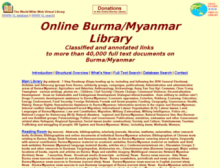Resource information
For centuries, that part of Southeast Asia which eventually became modern Burma
was largely isolated from, and ignorant of, the wider world. While visited by travelers
and traders from a very early date, and Europeans from the 14th century, Burma was
really only of strategic interest to its immediate neighbors, with whom it fought a
number of wars. India, China, and Thailand have all invaded, and been invaded by,
Burma at different times. As the major European empires expanded, however, and
geopolitics began to be practiced on a global scale, this situation changed and it
became more widely recognized that Burma occupied a geostrategic position of some
importance. It was, and still is, the place where South, Southeast, and East Asia meet,
and where the dominant cultures of these three subregions compete for influence. In
Samuel Huntington’s terms, it lies across the fault lines between three major civiliza -
tions, those of the Hindus, Buddhists, and Confucians. Also, at critical times, Burma
has been a cockpit for rivalry between the superpowers and, in the fluid strategic
environment of the early 21st century, its important position is once again attracting
attention from analysts and officials.


